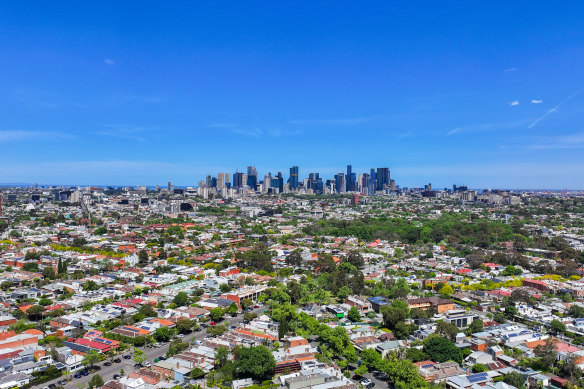By Josh Gordon and Broede Carmody
The arrival of almost 1 million new migrants to Australia over the past two years will necessitate a huge expansion of housing on Melbourne’s fringes, undermining the Allan government’s push to rein in urban sprawl, according to a new report.
The study from the Australian Population Research Institute argues opening up greenfield housing on Melbourne’s outer edge remains the only realistic short-term option to absorb an influx of new migrants and deal with the affordability crisis.

Further urban sprawl in Melbourne remains unavoidable, according to a new report.Credit: Joe Armao
It used 2021 census data to show that recently arrived migrants were initially far more likely to rent – placing pressure on rental prices – before acquiring the resources to buy a house after about five years.
“In the case of detached houses, we document that migrants arriving before 2016 are the largest source of purchasers of detached housing in Sydney and Melbourne, and that they dominate the ranks of buyers in the fringe suburbs of Melbourne,” authors David McCloskey and Dr Bob Birrell said.
The report follows the release of the state government’s housing statement in September last year, which included an ambitious target for the state to build an average of 80,000 new homes a year for the next decade to tackle housing affordability.
That would require a level of building activity that has never before been achieved.
According to the Australian Bureau of Statistics, just 51,512 new homes were started over the year to March, the lowest for a decade, with building activity being dragged down by high interest rates, skills shortages and other cost pressures.
The government also wants 70 per cent of housing development to take place in existing suburbs, with only 30 per cent on the fringes – a target it is also falling well short of.
More recently, it alarmed municipal governments after announcing draft targets for new houses for local councils, all of which far exceed past rates of housing building activity.
On Monday Premier Jacinta Allan insisted her government’s plan to increase housing density in Melbourne’s inner and middle-ring suburbs was viable and necessary.
“We can’t keep pumping all of that growth into our outer suburbs where pressure on services and infrastructure only grows greater,” Allan told those gathered at the Melbourne Convention and Exhibition Centre for the government’s housing summit.
“We can’t do this, because by 2051, Melbourne will be a city of 9 million people: the size that London is today.”
The premier added that Melbourne’s Suburban Rail Loop precincts were particularly “ripe” for housing growth.
“We can support larger growing communities in those places we know Victorians want to live.”
The report predicted the housing crisis would get worse after almost 1 million migrants added to Australia’s population in net terms in 2022 and 2023, with most moving to Melbourne and Sydney.
The migration surge, it said, would have a delayed impact.
“Similar delayed demand from the recent migration surge will add a huge impetus in
demand for detached housing in Sydney and Melbourne over the next decade,” the authors said in a statement.
The state government has suggested it is prepared to step in if local councils don’t find the required space to meet their targets for new housing.
In a statement to residents, Boroondara Mayor Lisa Hollingsworth said the target for her municipality would require an extra 67,000 additional homes by 2051 – equivalent to about 2400 new dwellings every year for the next 27 years.
“This is three times the average number of new homes built here, each year, over the past 10 years,” she said.
“We are not alone in being concerned at these unrealistic targets,” she said. “Multiple metropolitan councils share our position.”
Urban Development Institute of Australia Victorian chief executive Linda Allison said the premier had talked about pulling every policy lever to achieve its housing ambitions.
“We have consistently called out the lack of interest by government to examine the crippling property tax regime in Victoria,” she said.
“There was not so much as a hint that the government might be willing to explore even a temporary package to boost construction in the current difficult environment.
“You can’t say every lever is being pulled when industry can’t even have a conversation with the government about tax reform.”
With Kieran Rooney
Get the day’s breaking news, entertainment ideas and a long read to enjoy. Sign up to receive our Evening Edition newsletter here.